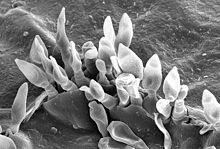Venturia inaequalis
| Venturia inaequalis | |
|---|---|
 |
|
| The reproductive conidia of Venturia inaequalis erupting through the cuticle of a crabapple leaf | |
| Scientific classification | |
| Kingdom: | Fungi |
| Division: | Ascomycota |
| Class: | Dothideomycetes |
| Order: | Pleosporales |
| Family: | Venturiaceae |
| Genus: | Venturia |
| Species: | V. inaequalis |
| Binomial name | |
|
Venturia inaequalis (Cooke) G.Winter (1875) |
|
| Synonyms | |
|
|
Venturia inaequalis is an ascomycete fungus that causes the Apple scab disease.
Venturia inaequalis anamorphs have been described under the names Fusicladium dendriticum and Spilocaea pomi. Whether V. inaequalis is a single species or contains several cryptic species has been a matter of debate for a long time. Recent genetic studies have revealed a considerable uniformity of the species. In addition, the fungus Spilocaea pyracanthae, a parasite of Pyracantha appeared not to genetically differ from V. inaequalis, being thus a special form of the latter.
The fruiting bodies, ascocarps appear in the form of pseudothecia. They are solitary and embedded into the host plant tissue. A pseudothecium has small dark hairs around its opening, and contains pseudoparaphyses along with asci. The asci contain eight haploid ascospores. The haploid chromosome number of V. inaequalis is seven.
The infection cycle begins in the springtime, when suitable temperatures and moisture promote the release of V. inaequalis ascospores.
These spores rise into the air and land on the surface of a susceptible tree, where they germinate and form a germ tube that can directly penetrate the plant's waxy cuticle. A fungal mycelium forms between the cuticle and underlying epidermal tissue, developing asexually the conidia, that germinate on fresh areas of the host tree, which in turn produce another generation of conidial spores. This cycle of secondary infections continues throughout the summer, until the leaves and fruit fall from the tree at the onset of winter.
V. inaequalis overwinters mostly as immature Perithecia, where sexual reproduction takes place, producing a new generation of ascospores that are released the following spring. Scab lesions located on the woody tissues may also overwinter in place, but will not undergo a sexual reproduction cycle; these lesions can still produce ineffective conidial spores in the spring.
...
Wikipedia
